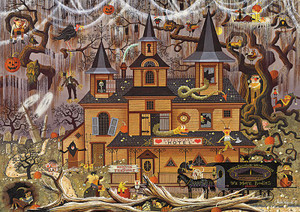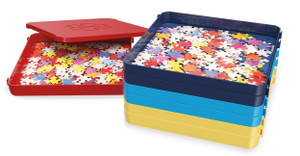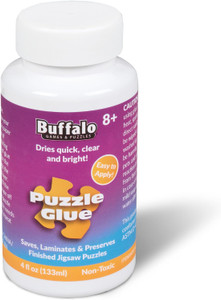Posted by Buffalo Games on Apr 6th 2022
The Easiest Way to Do a Jigsaw Puzzle
Jigsaw puzzles for adults and kids have seen a resurgence in popularity in light of the COVID-19 pandemic. With people being stuck at home, especially initially, sales soared for puzzle stores by 400% or more. Since the quarantine hit, the pastime has found a renewed place in homes across the country – and for a good reason.
The Benefits of Putting Puzzles Together
The benefits that puzzles provide are significant; people of all ages can put them together. Why should you get into completing puzzles? Some great reasons to spend your time with jigsaw puzzles include:
- They can be done in groups or alone
- You can relax and take your time assembling them
- They range in complexity from the very simple to masterfully complicated
- They can be hung in frames as home decor when assembled
- They are excellent activities to bring families together
In addition, putting puzzles together provides a slew of health benefits – especially mental health benefits. If you’re interested in keeping your mind nice and sharp, pick up jigsaw puzzles!
They also foster a sense of achievement and accomplishment, which benefits anyone. Some of the mental health benefits for adults and children include:
- Improves fine motor skills
- Enhances short-term memory
- Delays dementia and Alzheimer’s disease
- Reduces stress
- Improves visual-spatial reasoning
- Boosts hand-eye coordination
In addition, this kind of activity improves cognition, enhances focus and concentration, and is excellent as a meditation tool.
Puzzles work the right and left sides of the brain simultaneously. The left brain works linearly and is logical; the right brain is intuitive and creative. Both sides are engaged at once, improving problem-solving skills and a better attention span.
Did you know that people who work on jigsaw puzzles have longer life spans and less memory loss than those who don’t? In a study published in the Archives of Neurology, older adults who did puzzles regularly had brain scans that were similar to those of 25-year-olds.
Tips for Picking a Puzzle for an Elderly Loved One
Many people choose puzzles for loved ones who are elderly or have dementia or Alzheimer’s disease because of the benefits they provide. If you’re in the market for one, make sure you follow these tips so that you’re sure to get the right kind of puzzle:
First, don’t get a children’s puzzle that is too easy to complete. You don’t have to get a big 2,000-piece puzzle, but don’t get a 25-piece puzzle that can be done in five minutes. Consider starting with 100-piece puzzles and having your loved one work up.
You should also consider the size of the pieces: larger pieces may be necessary if your loved one has arthritis.
Don’t get overly complex puzzles or those with just a couple of colors. Find a challenging and stimulating puzzle, but not one that is frustrating or impossible.
Finally, choose a puzzle that displays a beautiful picture when it’s completed.
There are also specific puzzles designed for people with Alzheimer’s and dementia.
Tips for Doing Jigsaw Puzzles Like a Pro
The complexity and difficulty of a puzzle are proportional to the number of pieces. In addition, two other factors will influence how long completion will take.
These factors are the morphology of the pieces (how easily pieces are distinguishable) and the variety of the strokes and colors of pieces. The greater the variety, the easier the pieces are to separate, and the faster assembly will be.
Work on the Right Surface
Make sure you choose a work surface that allows pieces to slide across it quickly. In addition, you’ll want to select a surface that contrasts with the colors of the puzzle pieces so that each one is easier to differentiate from the others. You want the colors and patterns to stand out as much as possible.
Some people prefer to use a white surface, which reflects light well. Others prefer to use a black surface, such as a, because it’s easier on the eyes and provides exceptional contrast.
Light It Up
Whichever color and type of surface you use, make sure you have proper lighting. Few things increase the difficulty of 1,000-piece puzzleslike a poorly lit workspace!
Overhead ceiling lights work best; however, desk lamps or table lamps can be suitable too. Just be aware that these lamps can cast shadows on pieces. If you are using a desk lamp or table lamp, you might want to consider a cordless one to avoid mishaps with any cords.
Plan Your Attack
Different sizes of puzzles require different strategies for completing them. For example, you should have enough room to spread a 100-piece puzzle out entirely to view all of the pieces at once.
However, it isn’t easy to do that with a 2,000-piece puzzle. For these larger ones, remember that each piece contains a much smaller portion of the completed image, which means you will need to work on sorting the pieces into smaller groups.
In other words, you might be able to get away with not sorting pieces with smaller puzzles, but with larger ones, it’s essential. Keep all of your groups of puzzle pieces together, organized, and tidy with sorting trays.
Piece by Piece
Don’t spend time looking for corner pieces, especially if you’re working on a puzzle with 1,000 or more pieces. There are only four corners, making searching for them feel like searching for the proverbial needle in a haystack. Instead, pull out the edge pieces and start with those.
And don’t get stuck trying to find every single edge piece or every piece of a section before moving on. If you get stuck, move to a different section. The pieces you were looking for will eventually turn up. With all jigsaw puzzles, patience is the name of the game, and it will be well worth all of the effort in the end!


















































